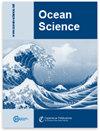Current observed global mean sea level rise and acceleration estimated from satellite altimetry and the associated measurement uncertainty
IF 3.3
3区 地球科学
Q2 METEOROLOGY & ATMOSPHERIC SCIENCES
引用次数: 4
Abstract
Abstract. We present the latest release of the global mean sea level (GMSL) record produced by the French space agency Centre National d’Etudes Spatiales (CNES) and distributed on the AVISO+ website. This dataset is based on reprocessed along-track data, so-called L2P 21, of the reference missions TOPEX/Poseidon (TP) and Jason-1, Jason-2 and Jason-3. The L2P 21 CNES/AVISO+ GMSL record covers the period January 1993 to December 2021 and is now delivered with an estimate of its measurement uncertainties following the method presented in Ablain et al. (2019). Based on the latest calibration (Cal) and validation (Val) knowledge, we updated the uncertainty budget of the reference altimetry mission measurements and demonstrate that the CNES/AVISO+ GMSL record now achieves stability of performances of ± 0.3 mm yr−1 at the 90 % confidence level (C.L.) for its trend and ±0.05 mm yr−2 (90 % C.L.) for its acceleration over the 29 years of the altimetry record. Thanks to an analysis of the relative contribution of each measurement uncertainty budget contributor, i.e. the altimeter, the radiometer, the orbit determination and the geophysical corrections, we identified the current limiting factors to the GMSL monitoring stability and accuracy. We find that the radiometer wet troposphere correction (WTC) and the high-frequency errors with timescales shorter than 1 year are the major contributors to the GMSL measurement uncertainty over periods of 10 years (30 %–70 %), for both the trend and acceleration estimations. For longer periods of 20 years, the TP data quality is still a limitation, but more interestingly, the International Terrestrial Reference Frame (ITRF) realization uncertainties becomes dominant over all the other sources of uncertainty. Such a finding challenges the altimetry observing system as it is designed today and highlights clear topics of research to be explored in the future to help the altimetry community to improve the GMSL measurement accuracy and stability.目前观测到的全球平均海平面上升和加速度,由卫星测高和相关的测量不确定度估算
摘要我们介绍由法国国家空间研究中心(CNES)制作的全球平均海平面(GMSL)记录的最新版本,并在AVISO+网站上发布。这个数据集是基于参考任务TOPEX/Poseidon (TP)和Jason-1、Jason-2和Jason-3的所谓L2P 21的重新处理的沿轨道数据。L2P 21 CNES/AVISO+ GMSL记录涵盖了1993年1月至2021年12月,现在根据Ablain等人(2019)提出的方法提供了其测量不确定度的估计。基于最新的校准(Cal)和验证(Val)知识,我们更新了参考测高任务测量的不确定度预算,并证明CNES/AVISO+ GMSL记录在其趋势的90%置信水平(C.L.)和加速度的±0.05 mm yr−2 (90% C.L.)下的稳定性达到了±0.3 mm yr−2。通过对高度计、辐射计、定轨和地球物理校正等测量不确定度预算贡献者的相对贡献分析,确定了当前限制GMSL监测稳定性和精度的因素。我们发现,在10年的时间尺度上,无论是趋势估计还是加速度估计,辐射计对流层湿校正(WTC)和短于1年的高频误差是造成GMSL测量不确定性的主要因素(30% - 70%)。在较长的20年期间,TP数据质量仍然是一个限制,但更有趣的是,国际地面参考框架(ITRF)实现的不确定性在所有其他不确定性来源中占主导地位。这一发现对当今设计的高度计观测系统提出了挑战,并突出了未来需要探索的明确研究课题,以帮助高度计界提高GMSL测量精度和稳定性。
本文章由计算机程序翻译,如有差异,请以英文原文为准。
求助全文
约1分钟内获得全文
求助全文
来源期刊

Ocean Science
地学-海洋学
CiteScore
5.90
自引率
6.20%
发文量
78
审稿时长
6-12 weeks
期刊介绍:
Ocean Science (OS) is a not-for-profit international open-access scientific journal dedicated to the publication and discussion of research articles, short communications, and review papers on all aspects of ocean science: experimental, theoretical, and laboratory. The primary objective is to publish a very high-quality scientific journal with free Internet-based access for researchers and other interested people throughout the world.
Electronic submission of articles is used to keep publication costs to a minimum. The costs will be covered by a moderate per-page charge paid by the authors. The peer-review process also makes use of the Internet. It includes an 8-week online discussion period with the original submitted manuscript and all comments. If accepted, the final revised paper will be published online.
Ocean Science covers the following fields: ocean physics (i.e. ocean structure, circulation, tides, and internal waves); ocean chemistry; biological oceanography; air–sea interactions; ocean models – physical, chemical, biological, and biochemical; coastal and shelf edge processes; paleooceanography.
 求助内容:
求助内容: 应助结果提醒方式:
应助结果提醒方式:


